Groundwater of the Modder River Catchment of South Africa: A Sustainability Prediction
Abstract
1. Introduction
2. Materials and Methods
2.1. Study Area
2.2. Geological Formation Present in the Modder River Catchment
2.3. Hydrogeology of the Modder River Catchment
2.4. Factors Affecting Groundwater Sustainability in Modder River Catchment
2.5. Theory/Calculation
2.5.1. Sustainability Concepts and Index
2.5.2. Rating of Hydrological Parameters
2.5.3. Factor (A) Climate
- A is the total score of all the parameters considered under Factor A;
- K is the sum of the score of all the parameters considered under Factor A;
- R is the rainfall;
- E is the evapotranspiration;
- S is the sunshine;
- T is the topography;
- V is the prevailing vegetation type;
- C is the climatic zones assessed.
2.5.4. Factor (B) Rights and Equity versus Resources
- B is the total score of all the parameters considered under Factor B;
- K is the score of all the parameters considered under Factor B;
- N is the number of the permit;
- L is the length or duration of permit years;
- B is the number of boreholes in the sub-catchment;
- P is the pumping rate.
2.5.5. Factor (C) Socioeconomics
- C is the total score of all the parameters considered under Factor C;
- k is the score of all the parameters considered under Factor C;
- U is the use per capital of the catchment;
- P is the population present in the catchment;
- W is the water uses;
- T is the tariffs.
2.5.6. Factor (D) Aquifer Sustainability
- D is the total score of all the parameters considered under factor D;
- k is the score of the parameter.
- A is the aquifer system in place;
- R is the rock type present;
- W is the water quality;
- Y is the aquifer yield;
- R is the recharge condition;
- S is the storage volume of the aquifer.
2.5.7. Sustainability Index
- A = Total score of the climatic condition factor (Factor A)
- B = Total score of the rights/equity factor (Factor B)
- C = Total score of the socioeconomic factor (Factor C)
- D = Total score of the aquifer sustainability factor (Factor D)
2.5.8. Groundwater Recharge Calculation of Modder Catchment
- Chloride mass balance (CMB) approach
- Empirical rainfall/recharge relationships
- Layer model (GIS based) approach
- Cross-calibration of the results with field measurements and detailed catchment studies.
- P is rainfall;
- Clp is the catchment’s chloride concentration of rainfall;
- Clr is the measured groundwater chloride concentration of the catchment;
- Q is the total discharge from the catchment;
- Clq is the average chloride concentration in the stream discharge, i.e., the Modder River.
3. Results
3.1. Sustainability Map
3.2. Comparison of Recharge and Sustainability Map
4. Discussion
4.1. How Sustainable Will Groundwater Be in the Catchment?
4.2. Groundwater Use versus Availability
5. Conclusions
Author Contributions
Funding
Conflicts of Interest
References
- Ponce, V.M. Groundwater Utilization and Sustainability: 78. Available online: http://groundwater.sdsu.edu/ (accessed on 12 July 2017).
- Rao, N.; Singh, C.; Solomon, D.; Camfield, L.; Sidiki, R.; Angula, M.; Poonacha, P.; Sidibé, A.; Lawson, E.T. Managing risk, changing aspirations and household dynamics: Implications for wellbeing and adaptation in semi-arid Africa and India. World Dev. 2020, 125, 104667. [Google Scholar] [CrossRef]
- Döring, S. Come rain, or come wells: How access to groundwater affects communal violence. Political Geogr. 2020, 76, 102073. [Google Scholar] [CrossRef]
- DWA (Department of Water Affairs). National Water Resource Strategy, 2nd ed.; Department of Water Affairs: Pretoria, South Africa, 2013.
- Wani, S.P.; Garg, K.K.; Singh, A.K.; Rockström, J. Sustainable Management of Scarce Water Resource in Tropical Rainfed Agriculture. In Soil Water and Agronomic Productivity. Advances in Soil Science; CRC Press: Boca Raton, FL, USA, 2012; pp. 347–408. [Google Scholar]
- Akurugu, B.A.; Chegbeleh, L.P.; Yidana, S.M. Characterisation of groundwater flow and recharge in crystalline basement rocks in the Talensi District, Northern Ghana. J. Afr. Earth Sci. 2020, 161, 103665. [Google Scholar] [CrossRef]
- Sophocleous, M. Groundwater recharge and sustainability in the High Plains aquifer in Kansas, USA. Hydrogeol. J. 2005, 13, 351–365. [Google Scholar] [CrossRef]
- Reddy, P.J.R. A Textbook of Hydrology; University Science Press: New Delhi, India, 2006; pp. 341–342. [Google Scholar]
- South Africa Department of Water and Sanitation (DWS). Groundwater Resource Assessment II. Available online: https://www.dws.gov.za/groundwater/GRAII.aspx (accessed on 18 January 2021).
- Molaba, G.L. Investigating the Possibility of Targeting Major Dolerite Intrusives to Supplement Municipal Water Supply in Bloemfontein: A Geophysical Approach. Master’s Thesis, University of the Free State, Bloemfontein, South Africa, 2017. [Google Scholar]
- Du Plessis, A. Current Water Quality Risk Areas for Vaal, Pongola-Mtamvuna and Orange WMAs. In Water as an Inescapable Risk; Springer: Berlin/Heidelberg, Germany, 2019; pp. 213–246. [Google Scholar]
- Du Toit, W.H.; Sonneku, C.J. An Explanation of the 1:500 000 General Hydrogeological Map, Nelspruit 2530; Department of Water and Sanitation: Pretoria, South Africa, 2014.
- Oldknow, C.; Hooke, J. Alluvial terrace development and changing landscape connectivity in the Great Karoo, South Africa. Insights from the Wilgerbosch River catchment, Sneeuberg. Geomorphology 2017, 288, 12–38. [Google Scholar] [CrossRef]
- Bezuidenhout, C. Macrophytes as indicators of physico-chemical factors in South African Estuaries. Ph.D. Thesis, Nelson Mandela Metropolitan University, Port Elizabeth, South Africa, 2011. [Google Scholar]
- Van der Zaag, P.; Carmo Vaz, Á. Sharing the Incomati waters: Cooperation and competition in the balance. Water Policy 2003, 5, 349–368. [Google Scholar] [CrossRef]
- Bicca, M.M.; Philipp, R.P.; Jelinek, A.R.; Ketzer, J.M.M.; Scherer, C.M.D.S.; Jamal, D.L.; dos Reis, A.D. Permian-Early Triassic tectonics and stratigraphy of the Karoo Supergroup in northwestern Mozambique. J. Afr. Earth Sci. 2017, 130, 8–27. [Google Scholar] [CrossRef]
- South African Committee for Stratigraphy (SACS). Lithostra-tigraphy of the Republic of South Africa, South West Africa/Namibia, and the Republics of Bophutatswana, Transkei and Venda; Republic of South Africa, Departament of Mineral and Energy Affairs, Geological Survey: Pretoria, South Africa, 1980.
- Vieira, H.M.; Weschenfelder, J.; Fernandes, E.H.; Oliveira, H.A.; Möller, O.O.; García-Rodríguez, F. Links between surface sediment composition, morphometry and hydrodynamics in a large shallow coastal lagoon. Sediment. Geol. 2020, 398, 105591. [Google Scholar] [CrossRef]
- Fuchs, S.; Cole, S. Making Science: Between Nature and Society. Soc. Forces 1994, 72, 929. [Google Scholar] [CrossRef]
- Milani, E.J.; De Wit, M.J. Correlations between the classic Paraná and Cape–Karoo sequences of South America and southern Africa and their basin infills flanking the Gondwanides: Du Toit revisited. Geol. Soc. London, Spéc. Publ. 2008, 294, 319–342. [Google Scholar] [CrossRef]
- Hälbich, I.W.; Fitch, F.J.; Miller, J.A. Dating the Cape Orogeny; The Geological Society of South Africa: Johannesburg, South Africa, 1983. [Google Scholar]
- Foden, J.; Elburg, M.; Turner, S.; Clark, C.; Blades, M.L.; Cox, G.; Collins, A.S.; Wolff, K.; George, C. Cambro-Ordovician magmatism in the Delamerian orogeny: Implications for tectonic development of the southern Gondwanan margin. Gondwana Res. 2020, 81, 490–521. [Google Scholar] [CrossRef]
- Wickens, H.V. Submarine fans of the Permian Ecca Group in the SW Karoo Basin: Their origin and reflection on the tectonic evolution of the basin and its source areas. In Inversion Tectonics of the Cape Fold Belt, Karoo and Cretaceous Basins of Southern Africa; De Wit, M.J., Ransome, I.G.D., Eds.; Balkema: Rotterdam, The Netherlands, 1992; pp. 117–126. [Google Scholar]
- Kingsley, C.S. A composite submarine fan-delta-fluvial model for the Ecca and lower Beaufort Groups of Permian age in the Eastern Cape Province, South Africa. South Afr. J. Geol. 1981, 84, 27–40. [Google Scholar]
- Osleger, D.; Hallam, A. Phanerozoic Sea-Level Changes. PALAIOS 1993, 8, 399. [Google Scholar] [CrossRef]
- Veevers, J.J.; Cole, D.I.; Cowan, E.J. Southern Africa: Karoo Basin and Cape Fold Belt. Geol. Soc. Am. Mem. 1994, 184, 223–280. [Google Scholar] [CrossRef]
- Madi, K. Neotectonics and its Applications for the Exploration of Groundwater in the Fractured Karoo Aquifers in the Eastern Cape, South Africa. Ph.D. Thesis, University of Fort Hare, Alice, South Africa, 2010. [Google Scholar]
- De Nora, O. Oronzio de Nora Impianti Elettrochimici SpA, Novel Electrolysis Cell. U.S. Patent 4,343,690, 8 November 1982. [Google Scholar]
- Catuneanu, O.; Hancox, P.J.; Rubidge, B.S. Reciprocal flexural behaviour and contrasting stratigraphies: A new basin development model for the Karoo retroarc foreland system, South Africa. Basin Res. 1998, 10, 417–439. [Google Scholar] [CrossRef]
- Andersen, T.; Kristoffersen, M.; Elburg, M.A. How far can we trust provenance and crustal evolution information from detrital zircons? A South African case study. Gondwana Res. 2016, 34, 129–148. [Google Scholar] [CrossRef]
- Duncan, R.A.; Hooper, P.R.; Rehacek, J.; Marsh, J.S.; Duncan, A.R. The timing and duration of the Karoo igneous event, southern Gondwana. J. Geophys. Res. Space Phys. 1997, 102, 18127–18138. [Google Scholar] [CrossRef]
- Swanevelder, C.J. Utilising South Africa’s largest river: The physiographic background to the Orange River scheme. GeoJournal 1981, 2, 29–40. [Google Scholar] [CrossRef]
- Woodford, A.C.; Chevallier, L.P. Regional Characterization and Mapping of Karoo Fractured Aquifer Systems: An Integrated Approach Using a Geographical Information System and Digital Image Processing; Water Research Commission: Pretoria, South Africa, 2002. [Google Scholar]
- Chere, N.; Linol, B.; De Wit, M.; Schulz, H.-M. Lateral and temporal variations of black shales across the southern Karoo Basin-Implications for shale gas exploration. South Afr. J. Geol. 2017, 120, 541–564. [Google Scholar] [CrossRef]
- Cooper, M.R. Cretaceous Fossils of South-Central Africa: An Illustrated Guide; CRC Press: Boca Raton, FL, USA, 2018. [Google Scholar]
- Hawthorne, J.B. Model of a kimberlite pipe. In Physics and Chemistry of the Earth, 1st ed.; Pergamon: Oxford, UK, 1975; ISBN 978-0-08-018017-5. [Google Scholar] [CrossRef]
- Dalton, T.J.S.; Paton, D.A.; Needham, D.T. Influence of mechanical stratigraphy on multi-layer gravity collapse structures: Insights from the Orange Basin, South Africa. Geol. Soc. Lond. Spec. Publ. 2017, 438, 211–228. [Google Scholar] [CrossRef]
- Hazell, J.R.T.; Cratchley, C.R.; Jones, C.R.C. The hydrogeology of crystalline aquifers in northern Nigeria and geophysical techniques used in their exploration. Geol. Soc. Lond. Spec. Publ. 1992, 66, 155–182. [Google Scholar] [CrossRef]
- Usher, B.; Pretorius, J.; Van Tonder, G. Management of a Karoo fractured-rock aquifer system—Kalkveld Water User Association (WUA). Water SA 2007, 32, 9–19. [Google Scholar] [CrossRef]
- Deal, J. Timeless Karoo; Penguin Random House South Africa: Pretoria, South Africa, 2016. [Google Scholar]
- Woyessa, Y.E.; Pretorius, E.; Van Heerden, P.S.; Hensley, M.; Van Rensburg, L.D. Impact of Land Use on River Basin Water Balance: A Case Study of the Modder River Basin, South Africa; IMWI: Colombo, Sri Lanka, 2006. [Google Scholar]
- Van Ginkel, C.E.; O’Keeffe, J.H.; Hughes, D.A.; Herald, J.R.; Ashton, P.J. A Situation Analysis of Water Quality in the Catchment of the Buffalo River, Eastern Cape with Special Emphasis on the Impacts of Low Cost, High-density Urban Development on Water Quality; Water Research Commission: Grahamstown, South Africa, 1996. [Google Scholar]
- Salama, R.B.; Otto, C.J.; Fitzpatrick, R.W. Contributions of groundwater conditions to soil and water salinization. Hydrogeol. J. 1999, 7, 46–64. [Google Scholar] [CrossRef]
- Sibley, D.F.; Blatt, H. Intergranular pressure solution and cementation of the Tuscarora orthoquartzite. J. Sediment. Res. 1976, 46, 881–896. [Google Scholar]
- Burger, M. Geohydrological Report for the Proposed Usutu Opencast Colliery on the Farms Jan Hendriksfontein 263 IT, Ermelo, Mpumalanga. Available online: https://sahris.sahra.org.za/sites/default/files/additionaldocs/Geohydrological_Report_-Usutu_Opencast_Colliery_May_2012_Draft_version_1.1.1-40.pdf (accessed on 18 January 2021).
- Aarnes, I.; Svensen, H.; Polteau, S.; Planke, S. Contact metamorphic devolatilization of shales in the Karoo Basin, South Africa, and the effects of multiple sill intrusions. Chem. Geol. 2011, 281, 181–194. [Google Scholar] [CrossRef]
- Swart, C.J.U.; James, A.R.; Kleywegt, R.J.; Stoch, E.J. The future of the dolomitic springs after mine closure on the Far West Rand, Gauteng, RSA. Environ. Earth Sci. 2003, 44, 751–770. [Google Scholar] [CrossRef]
- Schieferstein, B.; Loris, K. Ecological investigations on lichen fields of the Central Namib. Vegetatio 1992, 98, 113–128. [Google Scholar] [CrossRef]
- Vermeulen, P.D. A South African perspective on shale gas hydraulic fracturing. Proceedings of the International Mine Water Association Annual Conference 2012. pp. 146–149. Available online: http://www.mwen.info/docs/imwa_2012/IMWA2012_Vermeulen_149.pdf (accessed on 26 March 2021).
- Adams, S.; Titus, R.; Pietersen, K.; Tredoux, G.; Harris, C. Hydrochemical characteristics of aquifers near Sutherland in the Western Karoo, South Africa. J. Hydrol. 2001, 241, 91–103. [Google Scholar] [CrossRef]
- Steyl, G.; De Lange, F.; Mbinze, A. Hydrocensus and Groundwater Potential Assessment Bloemfontein; Mangaung Local Municipality, Institute for Groundwater Studies: Bloemfontein, South Africa, 2011. [Google Scholar]
- Nel, G.P. Geohydrological Characteristics of the Msikaba, Dwyka and Ecca Groups in the Lisikisiki area. Ph.D. Thesis, University of the Free State, Bloemfontein, South Africa, 2007. [Google Scholar]
- Singhal, B.B.S.; Gupta, R.P. Applied Hydrogeology of Fractured Rocks; Springer Science & Business Media: Berlin/Heidelberg, Germany, 2010. [Google Scholar]
- Botha, F.; Van Rooy, J. Affordable water resource development in the northern province, South Africa. J. Afr. Earth Sci. 2001, 33, 687–692. [Google Scholar] [CrossRef]
- Lyon, J.G.; Trimble, S.W.; Ward, A.D.; Burckhard, S.R. Environmental Hydrology; CRC Press: Boca Raton, FL, USA, 2015. [Google Scholar]
- Sanfo, S.; Barbier, B.; Dabiré, I.W.; Vlek, P.L.; Fonta, W.M.; Ibrahim, B.; Barry, B. Rainfall variability adaptation strategies: An ex-ante assessment of supplemental irrigation from farm ponds in southern Burkina Faso. Agric. Syst. 2017, 152, 80–89. [Google Scholar] [CrossRef]
- Zhao, J.; Ma, Y.; Luo, X.; Yue, D.; Shao, T.; Dong, Z. The discovery of surface runoff in the megadunes of Badain Jaran Desert, China, and its significance. Sci. China Earth Sci. 2017, 60, 707–719. [Google Scholar] [CrossRef]
- Tetsoane, S.T. Evaluation of the Swat Model in Simulating Catchment Hydrology: Case Study of the Modder River Basin. Ph.D. Thesis, Central University of Technology, Bloemfontein, South Africa, 2013. [Google Scholar]
- Zulkafli, Z.; Perez, K.; Vitolo, C.; Buytaert, W.; Karpouzoglou, T.; Dewulf, A.; De Bièvre, B.; Clark, J.; Hannah, D.M.; Shaheed, S. User-driven design of decision support systems for polycentric environmental resources management. Environ. Model. Softw. 2017, 88, 58–73. [Google Scholar] [CrossRef]
- Krause, T. Topography and its Effect on Groundwater. Available online: http://www.co.portage.wi.us/Groundwater/undrstnd/topo.html (accessed on 12 May 2017).
- Gabler, R.E.; Peterson, J.F.; Trapasso, L.M. Essentials of Physical Geography, 7th ed.; Brooks/Cole: Pacific Grove, CA, USA, 2004. [Google Scholar]
- Hasanuzzaman, M.; Song, X.; Han, D.; Zhang, Y.; Hussain, S. Prediction of Groundwater Dynamics for Sustainable Water Resource Management in Bogra District, Northwest Bangladesh. Water 2017, 9, 238. [Google Scholar] [CrossRef]
- Ward, R.C.; Robinson, M. Principles of Hydrology; McGraw-Hill: London, UK, 1990. [Google Scholar]
- Xanke, J.; Liesch, T.; Goeppert, N.; Klinger, J.; Gassen, N.; Goldscheider, N. Contamination risk and drinking water protection for a large-scale managed aquifer recharge site in a semi-arid karst region, Jordan. Hydrogeol. J. 2017, 25, 1795–1809. [Google Scholar] [CrossRef]
- Haggard, B.E.; Moore, P.A.; Brye, K.R. Effect of slope on runoff from a small variable slope boxplot. J. Environ. Hydrol. 2005, 13, 25. [Google Scholar]
- Khan, F.; Waliullah, M.N.; Bhatti, A.U. Maize Cultivar Response to Population Density and Planting Date for Grain and Biomass Yield. Sarhad J. Agric. 2007, 23, 25–30. [Google Scholar]
- Niehoff, D.; Fritsch, U.; Bronstert, A. Land-use impacts on storm-runoff generation: Scenarios of land-use change and simulation of hydrological response in a meso-scale catchment in SW-Germany. J. Hydrol. 2002, 267, 80–93. [Google Scholar] [CrossRef]
- Giertz, S.; Junge, B.; Diekkrüger, B. Assessing the effects of land use change on soil physical properties and hydrological processes in the sub-humid tropical environment of West Africa. Phys. Chem. Earth Parts A/B/C 2005, 30, 485–496. [Google Scholar] [CrossRef]
- Hundecha, Y.; Bárdossy, A. Modeling of the effect of land use changes on the runoff generation of a river basin through parameter regionalization of a watershed model. J. Hydrol. 2004, 292, 281–295. [Google Scholar] [CrossRef]
- Tang, Z.; Engel, B.; Pijanowski, B.; Lim, K. Forecasting land use change and its environmental impact at a watershed scale. J. Environ. Manag. 2005, 76, 35–45. [Google Scholar] [CrossRef]
- Klöcking, B.; Haberlandt, U. Impact of land use changes on water dynamics––a case study in temperate meso and macroscale river basins. Phys. Chem. Earth, Parts A/B/C 2002, 27, 619–629. [Google Scholar] [CrossRef]
- Girmay, G.; Singh, B.; Nyssen, J.; Borrosen, T. Runoff and sediment-associated nutrient losses under different land uses in Tigray, Northern Ethiopia. J. Hydrol. 2009, 376, 70–80. [Google Scholar] [CrossRef]
- Kashaigili, J. Impacts of land-use and land-cover changes on flow regimes of the Usangu wetland and the Great Ruaha River, Tanzania. Phys. Chem. Earth Parts A/B/C 2008, 33, 640–647. [Google Scholar] [CrossRef]
- Giertz, S.; Diekkrüger, B. Analysis of the hydrological processes in a small headwater catchment in Benin (West Africa). Phys. Chem. Earth Parts A/B/C 2003, 28, 1333–1341. [Google Scholar] [CrossRef]
- Wei, W.; Chen, L.; Fu, B.; Huang, Z.; Wu, D.; Gui, L. The effect of land uses and rainfall regimes on runoff and soil erosion in the semi-arid loess hilly area, China. J. Hydrol. 2007, 335, 247–258. [Google Scholar] [CrossRef]
- Jensen, J.L.; Schjønning, P.; Watts, C.W.; Christensen, B.T.; Munkholm, L.J. Soil texture analysis revisited: Removal of organic matter matters more than ever. PLoS ONE 2017, 12, e0178039. [Google Scholar] [CrossRef] [PubMed]
- Pidwirny, M. The Hydrologic. CycleFundamentals of Physical Geography, 2nd ed. Available online: http://www.physicalgeography.net/fundamentals/8b.htm (accessed on 6 February 2017).
- Schaetzl, R.; Anderson, S. Soils: Genesis and Geomorphology, 1st ed.; Cambridge University Press: Cambridge, UK, 2005. [Google Scholar]
- Ekwue, E.; Harrilal, A. Effect of soil type, peat, slope, compaction effort and their interactions on infiltration, runoff and raindrop erosion of some Trinidadian soils. Biosyst. Eng. 2010, 105, 112–118. [Google Scholar] [CrossRef]
- National Water Act of South Africa, Pretoria. 2014. Available online: https://www.gov.za/documents/national-water-act# (accessed on 18 January 2021).
- South Africa Department of Water and Sanitation (DWS). National Groundwater Resource: Assessment Phase II; Department of Water and Sanitation: Pretoria, South Africa, 2016.
- Woodford, A.; Girman, J. How Much Groundwater Does South Africa Have? Department of Water Affairs & Forestry: Pretoria, South Africa, January 2006; pp. 1–6. Available online: https://dxi97tvbmhbca.cloudfront.net/upload/user/image/1_A_Woodford20200304180745931.pdf (accessed on 18 January 2021).
- Pandey, V.P.; Shrestha, S.; Chapagain, S.K.; Kazama, F. A framework for measuring groundwater sustainability. Environ. Sci. Policy 2011, 14, 396–407. [Google Scholar] [CrossRef]
- Sami, K.; Hughes, D. A comparison of recharge estimates to a fractured sedimentary aquifer in South Africa from a chloride mass balance and an integrated surface-subsurface model. J. Hydrol. 1996, 179, 111–136. [Google Scholar] [CrossRef]
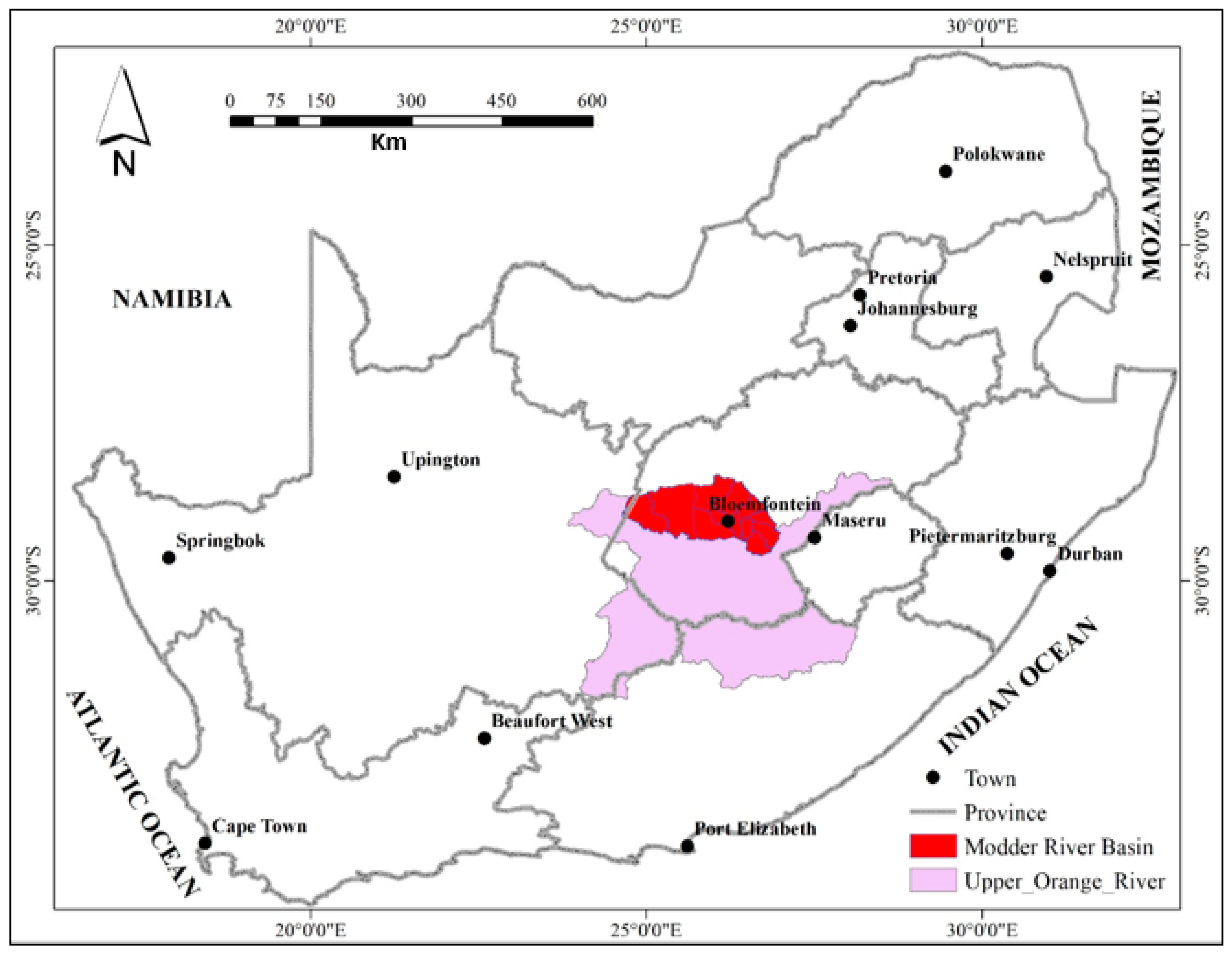
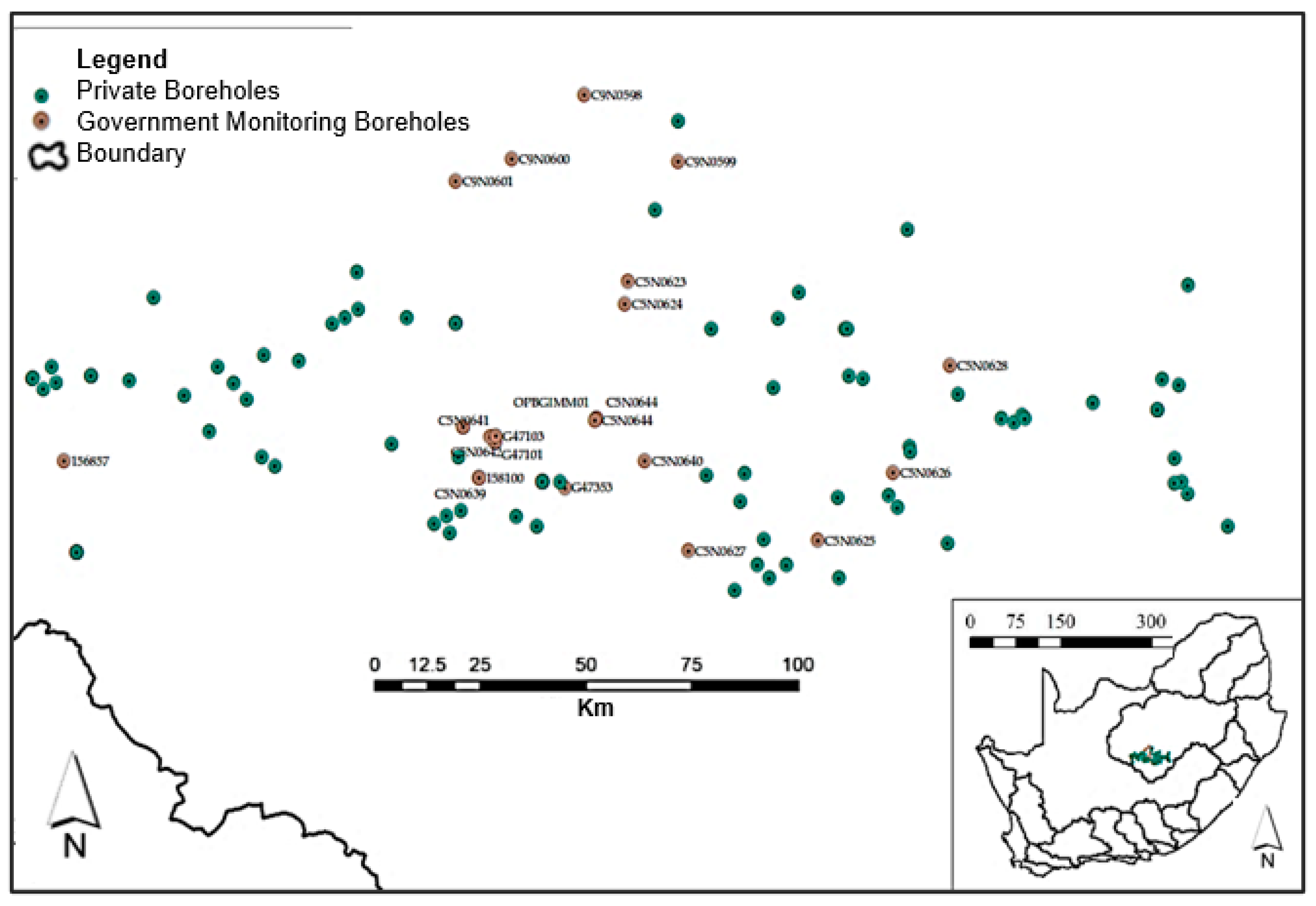
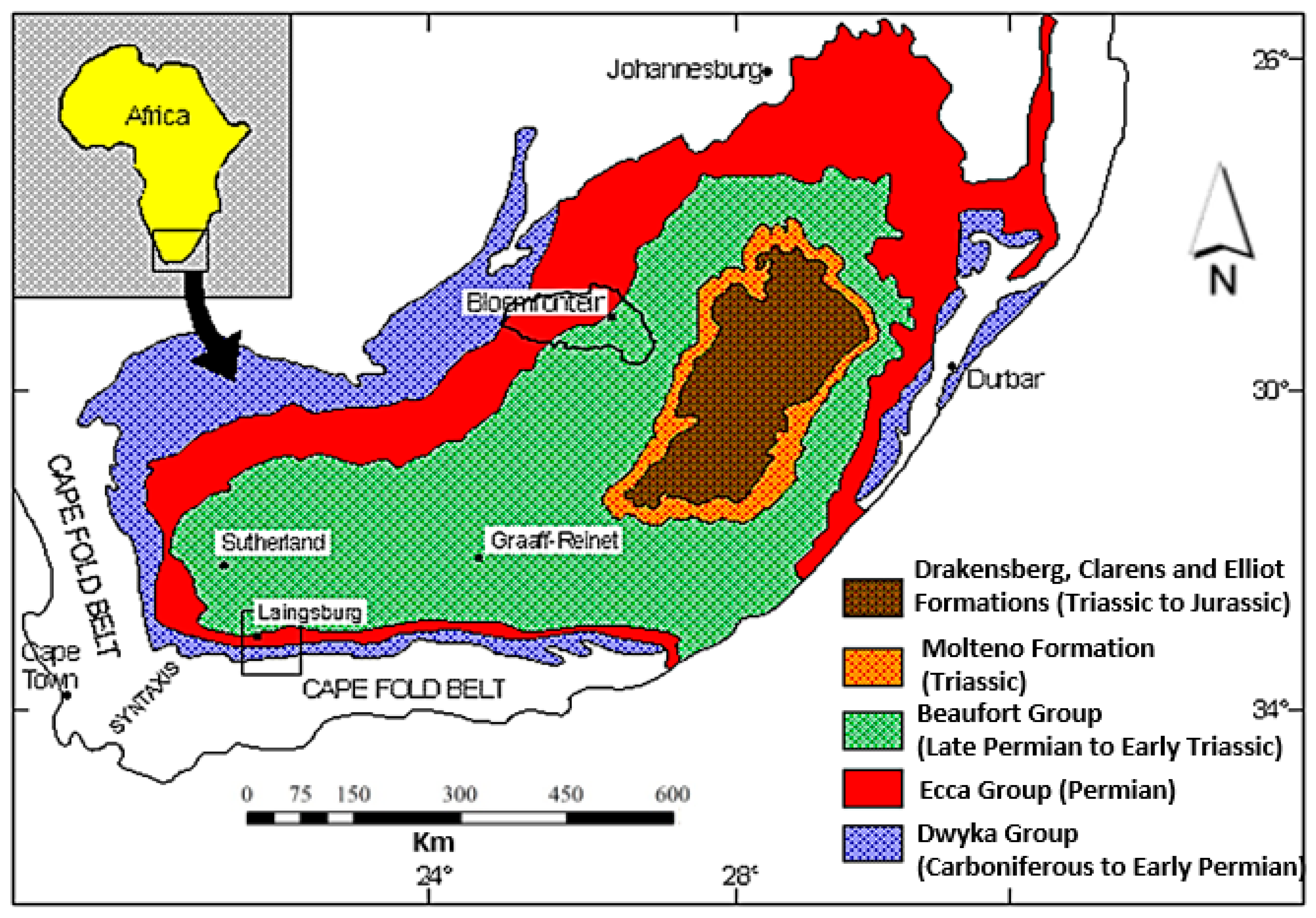
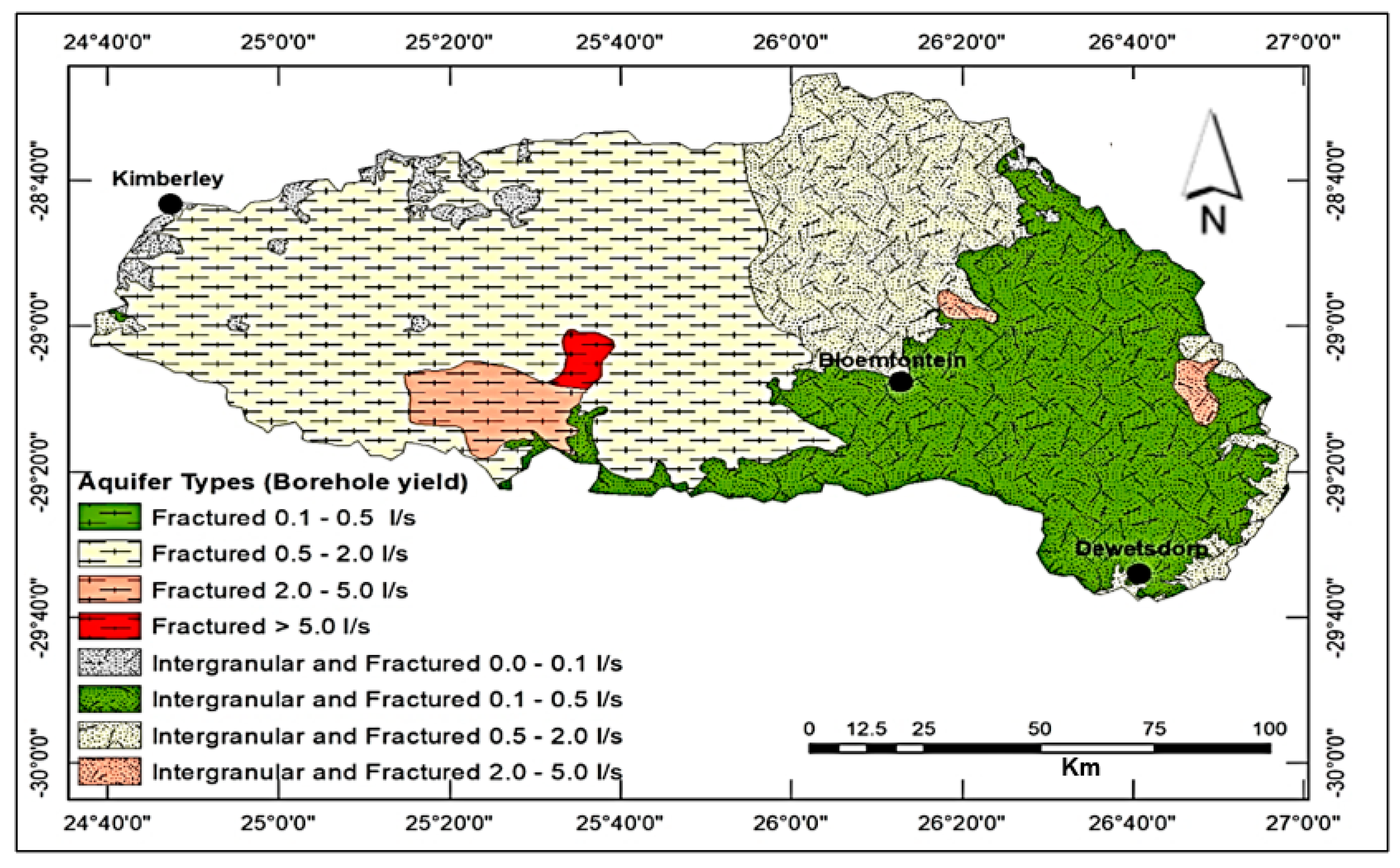
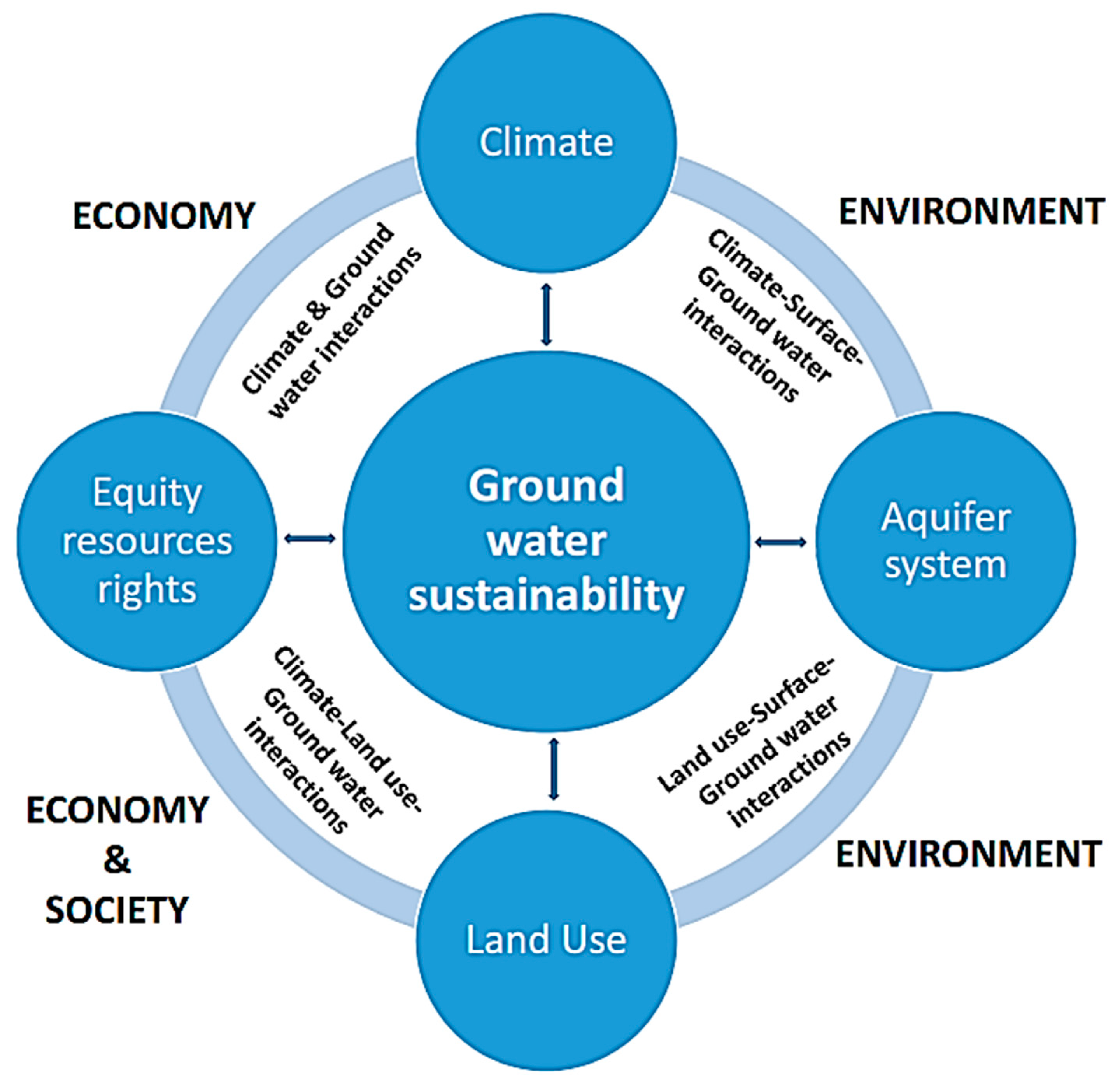
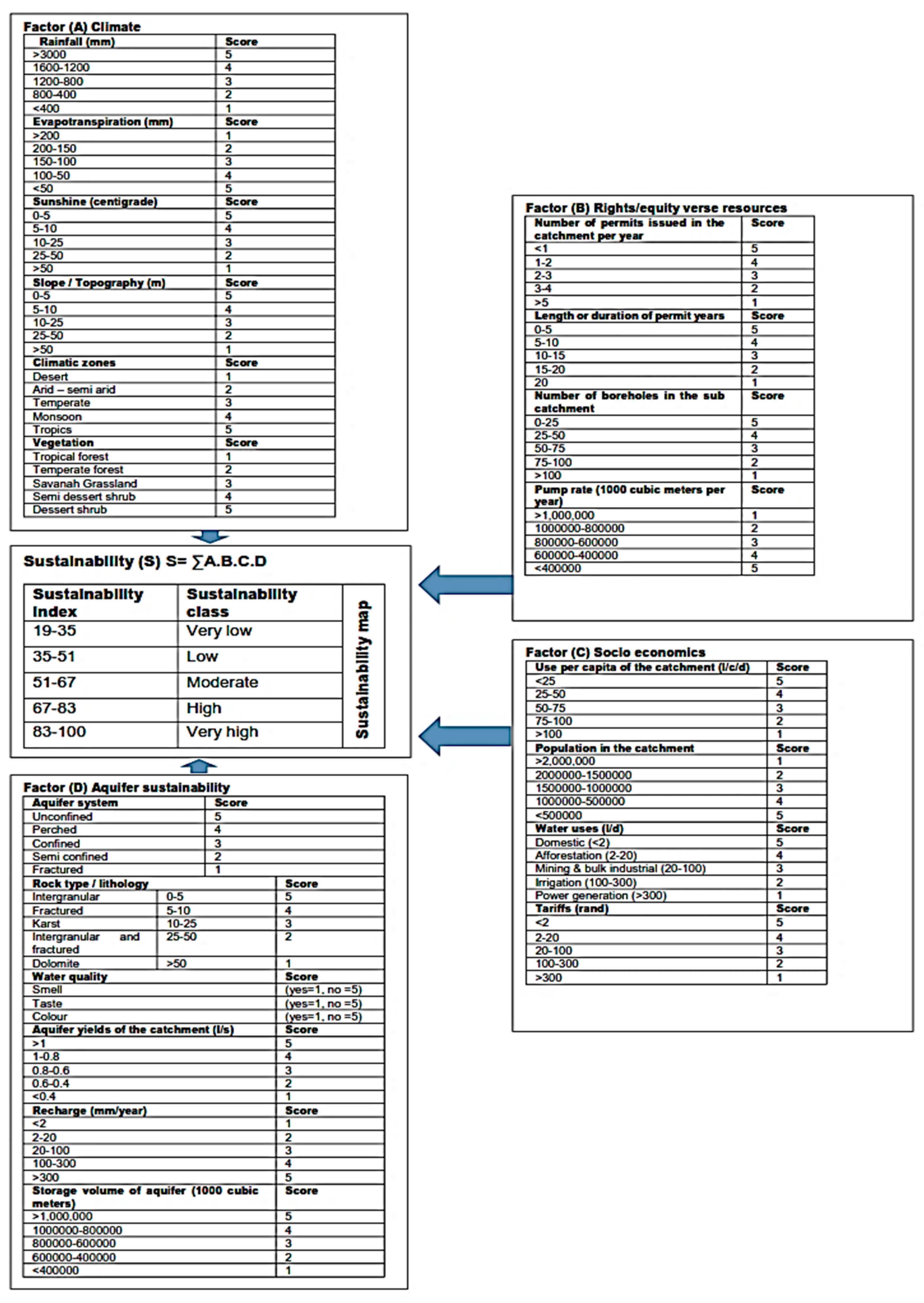
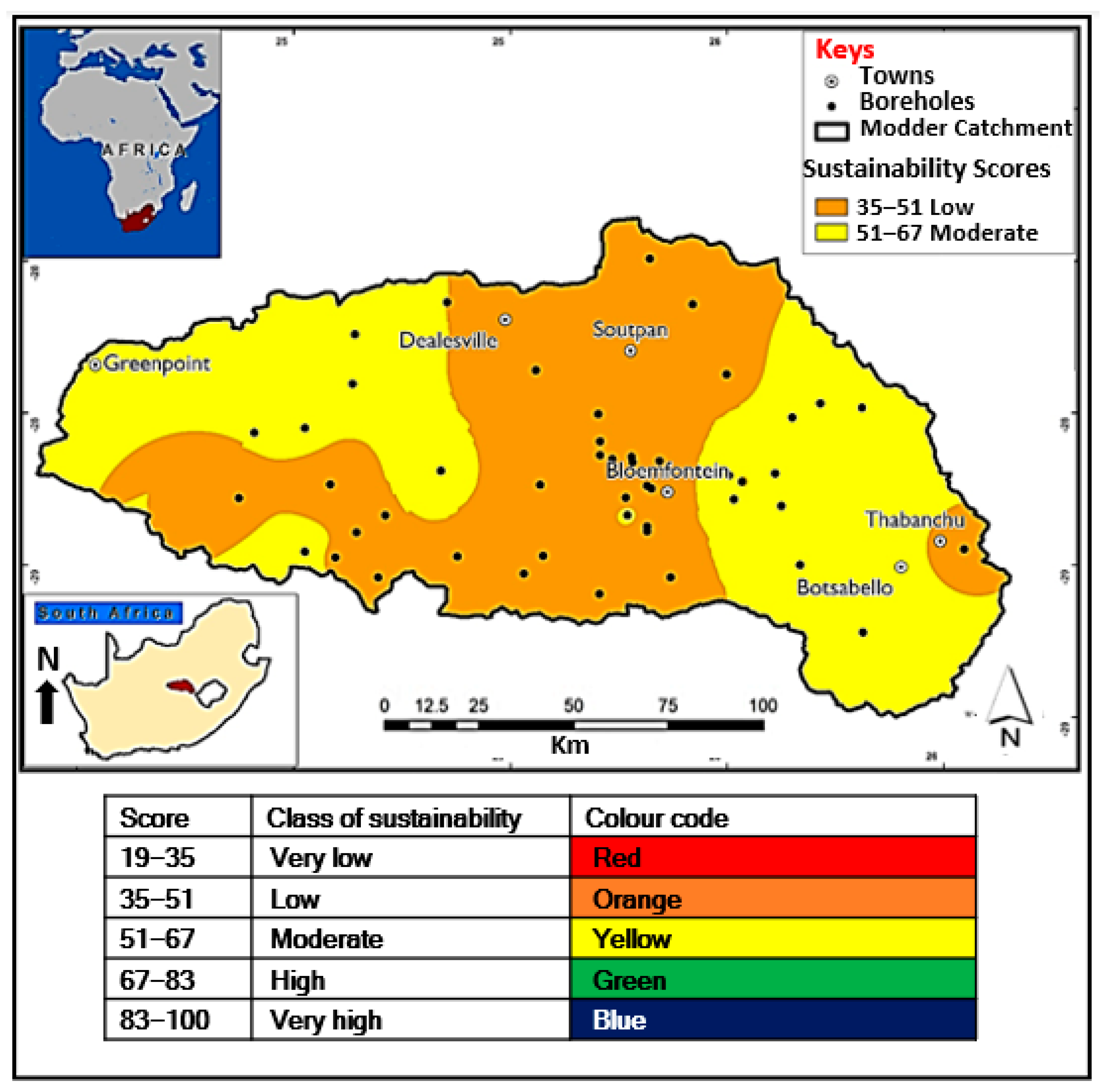
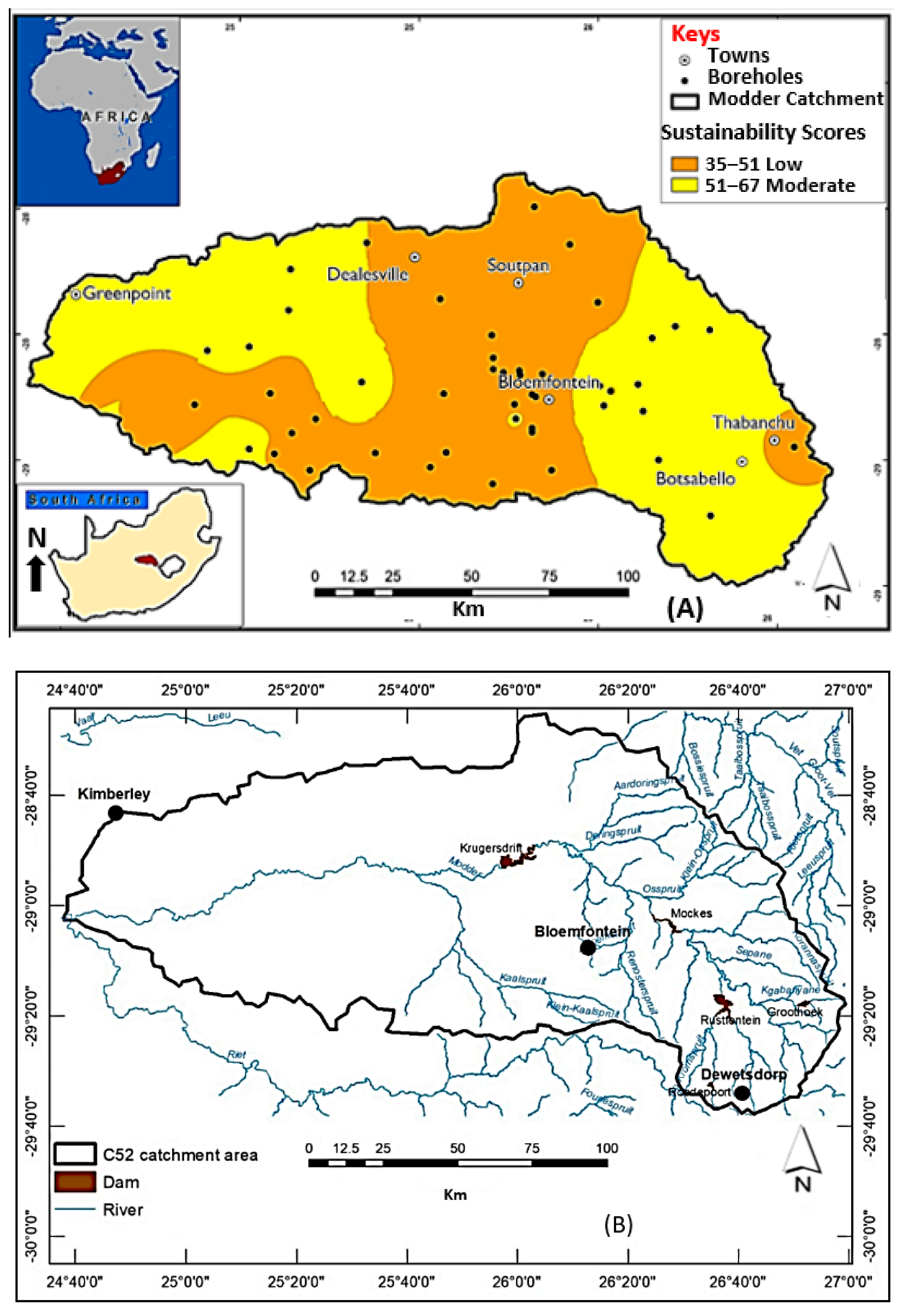
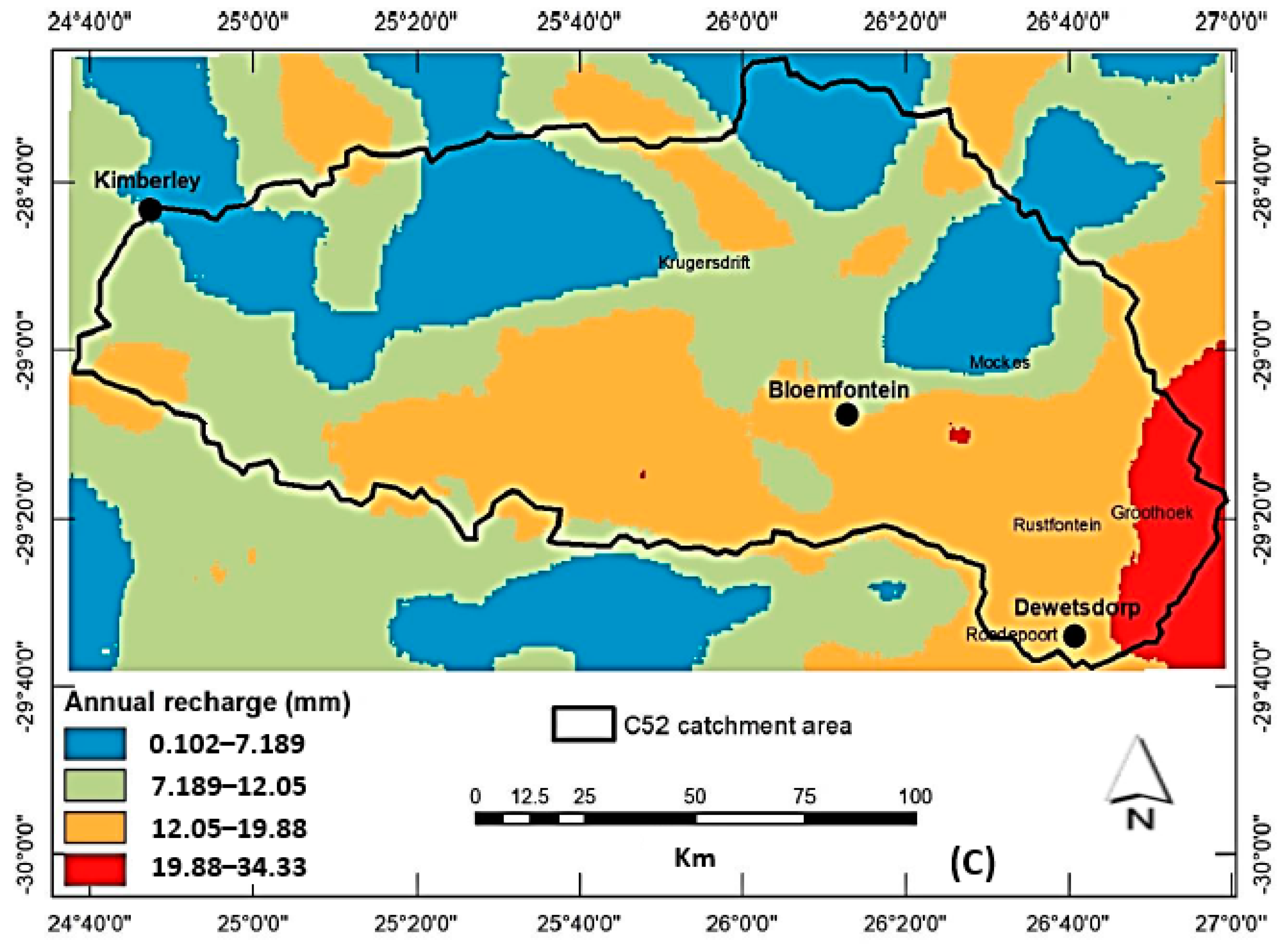
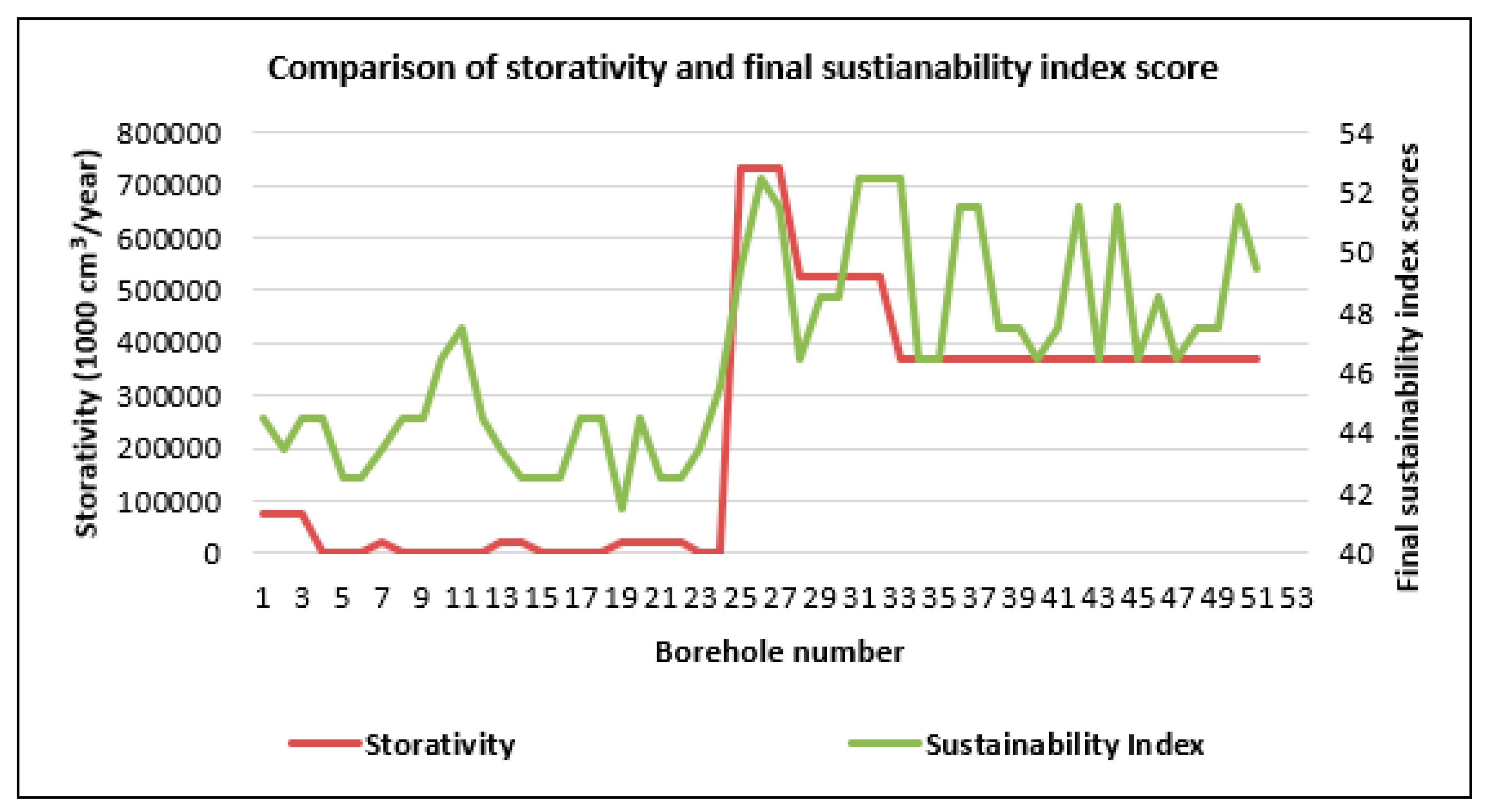
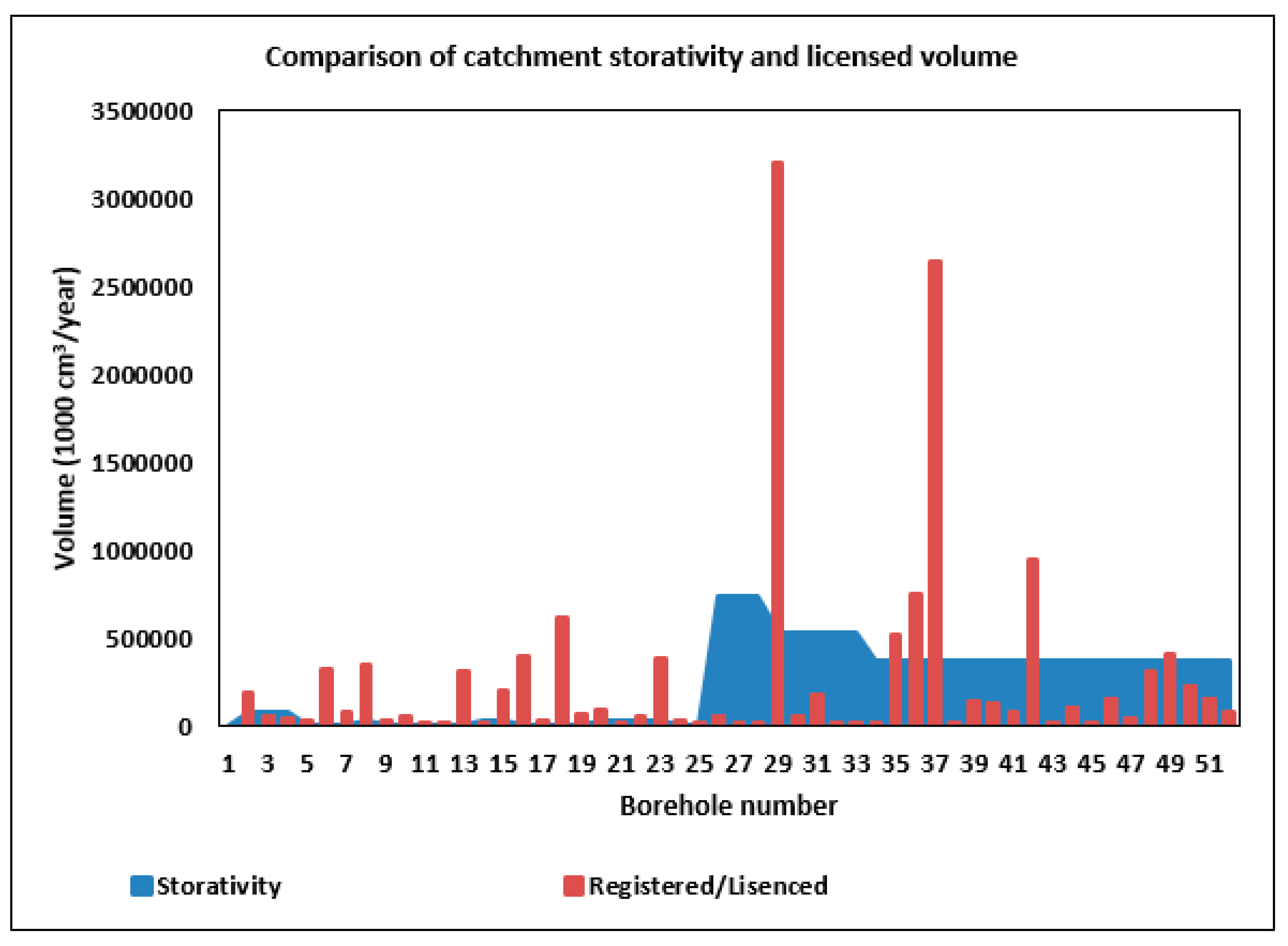
| Drainage Region | Storativity (in 1000 cm3/year) | Borehole | Sustainability Index | Sustainability Class |
|---|---|---|---|---|
| C52G | 74,320.5 | 1 | 44.5 | Low |
| C52G | 74,320.5 | 2 | 43.5 | Low |
| C52G | 74,320.5 | 3 | 44.5 | Low |
| C52H | 160.51 | 4 | 44.5 | Low |
| C52H | 160.51 | 5 | 42.5 | Low |
| C52H | 160.51 | 6 | 42.5 | Low |
| C52J | 22,668.67 | 7 | 43.5 | Low |
| C52H | 160.51 | 8 | 44.5 | Low |
| C52H | 160.51 | 9 | 44.5 | Low |
| C52H | 160.51 | 10 | 46.5 | Low |
| C52H | 160.51 | 11 | 47.5 | Low |
| C52H | 160.51 | 12 | 44.5 | Low |
| C52J | 22,668.67 | 13 | 43.5 | Low |
| C52J | 22,668.67 | 14 | 42.5 | Low |
| C52H | 160.51 | 15 | 42.5 | Low |
| C52H | 160.51 | 16 | 42.5 | Low |
| C52H | 160.51 | 17 | 44.5 | Low |
| C52H | 160.51 | 18 | 44.5 | Low |
| C52J | 22,668.67 | 19 | 41.5 | Low |
| C52J | 22,668.67 | 20 | 44.5 | Low |
| C52J | 22,668.67 | 21 | 42.5 | Low |
| C52J | 22,668.67 | 22 | 42.5 | Low |
| C52H | 160.51 | 23 | 43.5 | Low |
| C52B | 62.58 | 24 | 45.5 | Low |
| C52A | 73,4547.6 | 25 | 49.5 | Low |
| C52A | 73,4547.6 | 26 | 52.5 | Moderate |
| C52A | 73,4547.6 | 27 | 51.5 | Moderate |
| C52E | 52,7202.8 | 28 | 46.5 | Low |
| C52E | 52,7202.8 | 29 | 48.5 | Low |
| C52E | 52,7202.8 | 30 | 48.5 | Low |
| C52E | 52,7202.8 | 31 | 52.5 | Moderate |
| C52E | 52,7202.8 | 32 | 52.5 | Moderate |
| C52F | 36,8407.7 | 33 | 52.5 | Moderate |
| C52F | 36,8407.7 | 34 | 46.5 | Low |
| C52F | 36,8407.7 | 35 | 46.5 | Low |
| C52F | 36,8407.7 | 36 | 51.5 | Moderate |
| C52F | 36,8407.7 | 37 | 51.5 | Moderate |
| C52F | 36,8407.7 | 38 | 47.5 | Low |
| C52F | 36,8407.7 | 39 | 47.5 | Low |
| C52F | 36,8407.7 | 40 | 46.5 | Low |
| C52F | 36,8407.7 | 41 | 47.5 | Low |
| C52F | 36,8407.7 | 42 | 51.5 | Moderate |
| C52F | 36,8407.7 | 43 | 46.5 | Low |
| C52F | 36,8407.7 | 44 | 51.5 | Moderate |
| C52F | 36,8407.7 | 45 | 46.5 | Low |
| C52F | 36,8407.7 | 46 | 48.5 | Low |
| C52F | 36,8407.7 | 47 | 46.5 | Low |
| C52F | 36,8407.7 | 48 | 47.5 | Low |
| C52F | 36,8407.7 | 49 | 47.5 | Low |
| C52F | 36,8407.7 | 50 | 51.5 | Moderate |
| C52F | 36,8407.7 | 51 | 49.5 | Low |
Publisher’s Note: MDPI stays neutral with regard to jurisdictional claims in published maps and institutional affiliations. |
© 2021 by the authors. Licensee MDPI, Basel, Switzerland. This article is an open access article distributed under the terms and conditions of the Creative Commons Attribution (CC BY) license (http://creativecommons.org/licenses/by/4.0/).
Share and Cite
Oke, S.A.; Alowo, R. Groundwater of the Modder River Catchment of South Africa: A Sustainability Prediction. Water 2021, 13, 936. https://doi.org/10.3390/w13070936
Oke SA, Alowo R. Groundwater of the Modder River Catchment of South Africa: A Sustainability Prediction. Water. 2021; 13(7):936. https://doi.org/10.3390/w13070936
Chicago/Turabian StyleOke, Saheed Adeyinka, and Rebecca Alowo. 2021. "Groundwater of the Modder River Catchment of South Africa: A Sustainability Prediction" Water 13, no. 7: 936. https://doi.org/10.3390/w13070936
APA StyleOke, S. A., & Alowo, R. (2021). Groundwater of the Modder River Catchment of South Africa: A Sustainability Prediction. Water, 13(7), 936. https://doi.org/10.3390/w13070936







